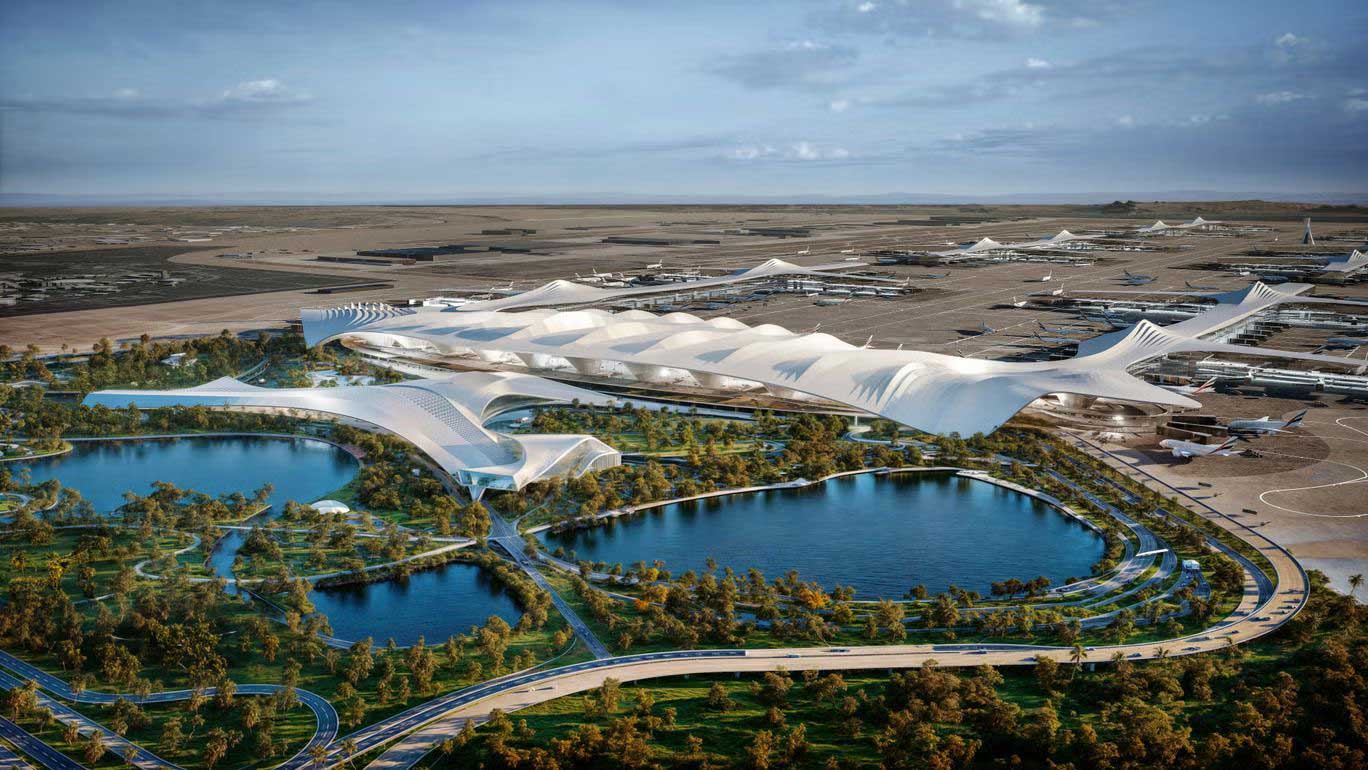Dubai has unveiled a bold and visionary step into the future of global air travel. The emirate’s second international gateway—Al Maktoum International Airport (DWC)—is undergoing a massive expansion, with the first phase scheduled to be completed by 2032, targeting an impressive annual passenger capacity of 150 million.
With the goal of becoming the world’s largest and most advanced airport, the project is not just a transportation hub but the backbone of an emerging smart city at Dubai South. Once the first phase becomes operational, it will gradually replace Dubai International Airport (DXB) as the city’s main aviation hub.
A Vision Approved at the Highest Level
His Highness Sheikh Mohammed bin Rashid Al Maktoum, Vice President and Prime Minister of the UAE and Ruler of Dubai, recently approved the futuristic designs for the new airport. The project has been greenlit with a colossal AED 128 billion ($35 billion) investment.
The plan includes a new terminal building five times the size of DXB, 400 aircraft gates, and 5 parallel runways—making it the largest airport development globally in terms of scale and capacity.
“We are building a new project for future generations, ensuring continuous and stable development for our children and their children,” said Sheikh Mohammed.
Highlights of the Al Maktoum Expansion Project
Key Infrastructure Details:
-
Capacity (Phase One): 150 million passengers per year by 2032
-
Ultimate Capacity: Up to 260 million passengers annually
-
Runways: 5 parallel runways
-
Aircraft Gates: 400+
-
Terminal Buildings: 4 satellite concourses
-
Automated People Mover: Uninterrupted connectivity across terminals
-
Transport Integration: Metro, roads, and air-rail links via a central transport hub
Dubai South: The Future Aviation City
Dubai’s new airport is not just a transport upgrade—it’s a smart city in the making. Designed to host over a million residents and workers, Dubai South will become a thriving urban zone centered around DWC. The area will attract aerospace companies, cargo hubs, logistics operators, and aviation tech firms from around the world.
“We’re not only building an airport. We are building a whole city around the airport in Dubai South to host the world’s leading companies in logistics and air transport,” Sheikh Mohammed emphasized.
Dh1 Billion Runway Deal Signed
As part of this massive development, a Dh1 billion ($270M) contract has been awarded for the construction of a second runway at DWC. The announcement came during The Airport Show 2024, where Khalifa Al Zaffin, Executive Chairman of Dubai Aviation City Corporation, stated:
“We are moving decisively. Talks with global contractors are ongoing. We are committed to delivering the most futuristic airport in the world—on time.”
Why This Matters Globally
Al Maktoum International is poised to disrupt global aviation dynamics. The shift from DXB to DWC over the next 10 years will mark a new chapter in how people travel to, through, and from the Middle East.
Global Implications:
-
International Transit Hub: Direct connectivity to six continents.
-
Cargo Capacity: One of the world’s largest air freight hubs.
-
Tourism & Trade: Supporting Dubai’s growing status as a global business capital.
According to Paul Griffiths, CEO of Dubai Airports:
“All operations will eventually shift from DXB to DWC. This is a carefully phased transformation, ensuring zero disruption and exponential growth.”
Sustainability & Smart Innovation
The airport is being built with sustainability and digitization at its core. Features include:
-
LEED Gold Certification Goals
-
Energy-efficient systems and green buildings
-
Digital passenger journey: Biometric check-in, AI-driven baggage handling, and autonomous transport
-
Smart logistics infrastructure: Powered by AI, blockchain, and real-time cargo tracking
Timeline of the Al Maktoum Airport Project
| Year | Milestone |
|---|---|
| 2024 | AED 128B investment announced; runway contract awarded |
| 2025–2027 | Construction of terminals and runways |
| 2028–2030 | Transport hub and smart city infrastructure development |
| 2032 | First phase completed – 150 million passenger capacity operational |
| 2032–2040 | Full transition from DXB to DWC |
| Beyond 2040 | Scaling up to 260 million passengers |
Economic Impact and Job Creation
This project is more than an aviation story—it’s an economic catalyst.
-
Over 1 million jobs expected to be supported through aviation, logistics, real estate, and tech.
-
Massive boost to Dubai’s GDP, particularly in aviation, trade, and tourism.
-
Residential demand in Dubai South is projected to skyrocket, with supporting infrastructure such as schools, hospitals, and retail zones already in planning.
Why Dubai Is Building the World’s Largest Airport
-
DXB is nearing full capacity despite being the world’s busiest international airport.
-
Passenger traffic to exceed 100M in 2024 alone
-
Strategic geographic location connecting East and West within 8 hours of flight time
-
Dubai’s ambition to lead in global trade, AI logistics, and sustainable air travel
What’s Next for Dubai’s Aviation Scene?
Dubai has never been shy of setting global benchmarks—from the world’s tallest building to record-breaking airports. With the first phase of Al Maktoum International set to open by 2032, it will redefine travel, set new global standards, and transform the face of aviation.
This is more than an airport—it’s Dubai’s gateway to the future.
Summary
-
Project: Dubai’s New Airport – Al Maktoum International (DWC)
-
Phase One Completion: By 2032
-
Initial Passenger Capacity: 150 million per year
-
Investment: AED 128 Billion ($35 Billion)
-
Runways: 5
-
Aircraft Gates: 400+
-
Smart City: Built around Dubai South for 1M+ residents
-
Shift from DXB: Gradual and complete post-2032
-
Sustainability: Core design focus
-
Economic Growth: Major GDP and job impact across UAE
YAllA TV – www.yallatv.ae





